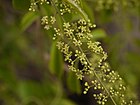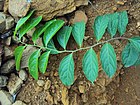Note: This is a project under development. The articles on this wiki are just being initiated and broadly incomplete. You can Help creating new pages.
Difference between revisions of "Celastrus paniculatus - Jyotishmati"
(→Fruit) |
|||
| Line 2: | Line 2: | ||
'''Jyotishmati''' is a deciduous, climbing shrub. The stems twine into the surrounding vegetation, helping to support themselves by means of hooked prickles. The plant is harvested from the wild for local use as a medicine and source of oil. | '''Jyotishmati''' is a deciduous, climbing shrub. The stems twine into the surrounding vegetation, helping to support themselves by means of hooked prickles. The plant is harvested from the wild for local use as a medicine and source of oil. | ||
==Uses== | ==Uses== | ||
| − | {{Uses|Memory loss}}, {{Uses|Rheumatic arthritis}}, {{Uses|Insomnia}}, {{Uses|Opium poisoning}}, {{Uses|Impotence}} | + | {{Uses|Memory loss}}, {{Uses|Rheumatic arthritis}}, {{Uses|Insomnia}}, {{Uses|Opium poisoning}}, {{Uses|Impotence}}<ref name="Uses"/> |
| − | <ref name="Uses"/> | + | |
| + | ===Food=== | ||
| + | Jyotishmati can be used in food. Unripe fruits are boiled and eaten as vegetable. | ||
==Parts Used== | ==Parts Used== | ||
| − | {{Parts Used|Seeds}}, {{Parts Used|Leaves}} | + | {{Parts Used|Seeds}}, {{Parts Used|Leaves}}, {{Parts Used|Fruits}}. |
| + | |||
==Chemical Composition== | ==Chemical Composition== | ||
The seeds are reported to contain the alkaloids, celastrine and paniculatine, which are the active principles of the drug. <ref name="Chemical composition"/> | The seeds are reported to contain the alkaloids, celastrine and paniculatine, which are the active principles of the drug. <ref name="Chemical composition"/> | ||
| Line 29: | Line 32: | ||
Vata, Kapha | Vata, Kapha | ||
===Prabhava=== | ===Prabhava=== | ||
| + | ===Nutritional components=== | ||
| + | Jyotishmaticontains the Following nutritional components likeVitamin-C; Calcium, Iron, Magnesium, Maganese, Potassium, Phosphorus, Sodium, Zinc. | ||
==Habit== | ==Habit== | ||
| Line 74: | Line 79: | ||
File:Celastrus paniculatus 15.JPG | File:Celastrus paniculatus 15.JPG | ||
File:Celastrus paniculatus 03.JPG | File:Celastrus paniculatus 03.JPG | ||
| − | |||
| − | |||
| − | |||
</gallery> | </gallery> | ||
==References== | ==References== | ||
| − | |||
<references> | <references> | ||
<ref name="Uses">[https://www.ayurtimes.com/celastrus-paniculatus-jyotishmati-malkangani/ Uses]</ref> | <ref name="Uses">[https://www.ayurtimes.com/celastrus-paniculatus-jyotishmati-malkangani/ Uses]</ref> | ||
<ref name="Chemical composition">[http://gbpihedenvis.nic.in/PDFs/Glossary_Medicinal_Plants_Springer.pdf Chemical composition]</ref> | <ref name="Chemical composition">[http://gbpihedenvis.nic.in/PDFs/Glossary_Medicinal_Plants_Springer.pdf Chemical composition]</ref> | ||
| − | |||
<ref name="Leaf">Kappatagudda - A Repertoire of Medicianal Plants of Gadag by Yashpal Kshirasagar and Sonal Vrishni, Page No. 119</ref> | <ref name="Leaf">Kappatagudda - A Repertoire of Medicianal Plants of Gadag by Yashpal Kshirasagar and Sonal Vrishni, Page No. 119</ref> | ||
<ref name="Common names">[http://envis.frlht.org/bot_search Vernacular names]</ref> | <ref name="Common names">[http://envis.frlht.org/bot_search Vernacular names]</ref> | ||
<ref name="Ayurvedic properties">[https://easyayurveda.com/2012/12/05/jyotishmati-medicinal-qualities-ayurveda-benefits-and-dose/ Ayurvedic properties]</ref> | <ref name="Ayurvedic properties">[https://easyayurveda.com/2012/12/05/jyotishmati-medicinal-qualities-ayurveda-benefits-and-dose/ Ayurvedic properties]</ref> | ||
| − | |||
| − | |||
</references> | </references> | ||
Revision as of 14:43, 18 October 2021
Jyotishmati is a deciduous, climbing shrub. The stems twine into the surrounding vegetation, helping to support themselves by means of hooked prickles. The plant is harvested from the wild for local use as a medicine and source of oil.
Contents
- 1 Uses
- 2 Parts Used
- 3 Chemical Composition
- 4 Common names
- 5 Properties
- 6 Habit
- 7 Identification
- 8 List of Ayurvedic medicine in which the herb is used
- 9 Where to get the saplings
- 10 Mode of Propagation
- 11 How to plant/cultivate
- 12 Commonly seen growing in areas
- 13 Photo Gallery
- 14 References
- 15 External Links
Uses
Memory loss, Rheumatic arthritis, Insomnia, Opium poisoning, Impotence[1]
Food
Jyotishmati can be used in food. Unripe fruits are boiled and eaten as vegetable.
Parts Used
Chemical Composition
The seeds are reported to contain the alkaloids, celastrine and paniculatine, which are the active principles of the drug. [2]
Common names
| Language | Common name |
|---|---|
| Kannada | Bhavanga beeja, Gangunde kaayi, Gangunga hambu, Maala kanguni |
| Hindi | Malakanguni, Mlkauni |
| Malayalam | Ceruppunna, Palulavam, Paluzhavam |
| Tamil | Carasvati, Acuvalakkal, Malgangunicinnavaluluvai |
| Telugu | Baavanji, Gandumida, |
| Marathi | NA |
| Gujarathi | NA |
| Punjabi | NA |
| Kashmiri | NA |
| Sanskrit | Agnibhasa, Jyotishlata, Jyotishmati, Supingala, Swarna lata |
| English | Black oil plant |
Properties
Reference: Dravya - Substance, Rasa - Taste, Guna - Qualities, Veerya - Potency, Vipaka - Post-digesion effect, Karma - Pharmacological activity, Prabhava - Therepeutics.
Dravya
Rasa
Tikta (Bitter), Katu (Pungent)
Guna
Teekshna (Strong), Snigdha (Oily)
Veerya
Ushna (Hot)
Vipaka
Katu (Pungent)
Karma
Vata, Kapha
Prabhava
Nutritional components
Jyotishmaticontains the Following nutritional components likeVitamin-C; Calcium, Iron, Magnesium, Maganese, Potassium, Phosphorus, Sodium, Zinc.
Habit
Identification
Leaf
| Kind | Shape | Feature |
|---|---|---|
| Simple | Alternate | Broadly ovate, apex abruptly acuminate, base ronded or acute, crenulate; petiole 6 mm long |
Flower
| Type | Size | Color and composition | Stamen | More information |
|---|---|---|---|---|
| Bisexual | Terminal and axillary panicles | Yellowish white | 5 | Panicle to 15 x 8 cm, terminal, axillary, oblong; pedicel 6 mm long; flowers many, 6 mm across. Sepals 5, small, imbricate, ciliate. Petals 2.5 x 2 mm, white, ovate, obtuse. Stamens 5, erect, anthers sagitate at base. Ovary 3-celled, cell 2-ovuled, stigma 3, recurved. |
Fruit
| Type | Size | Mass | Appearance | Seeds | More information |
|---|---|---|---|---|---|
| A capsule | 1cm | Loculicidal, yellow | Seeds 3, aril reddish. | {{{5}}} | {{{6}}} |
Other features
List of Ayurvedic medicine in which the herb is used
Where to get the saplings
Mode of Propagation
How to plant/cultivate
Season to grow
Soil type
Propagation
Commonly seen growing in areas
Photo Gallery
References
- ↑ Uses
- ↑ Chemical composition
- ↑ Vernacular names
- ↑ Kappatagudda - A Repertoire of Medicianal Plants of Gadag by Yashpal Kshirasagar and Sonal Vrishni, Page No. 119
- ↑ Ayurvedic properties
External Links
- Ayurvedic Herbs known to be helpful to treat Memory loss
- Ayurvedic Herbs known to be helpful to treat Rheumatic arthritis
- Ayurvedic Herbs known to be helpful to treat Insomnia
- Ayurvedic Herbs known to be helpful to treat Opium poisoning
- Ayurvedic Herbs known to be helpful to treat Impotence
- Herbs with Seeds used in medicine
- Herbs with Leaves used in medicine
- Herbs with Fruits used in medicine
- Herbs with common name in Kannada
- Herbs with common name in Hindi
- Herbs with common name in Malayalam
- Herbs with common name in Tamil
- Herbs with common name in Telugu
- Herbs with common name in Sanskrit
- Herbs with common name in English
- Habit - Climber
- Index of Plants which can be propagated by Seeds
- Index of Plants which can be propagated by Cuttings
- Herbs that are commonly seen in the region of Tropical area
- Herbs
- Climber
- Celastraceae





